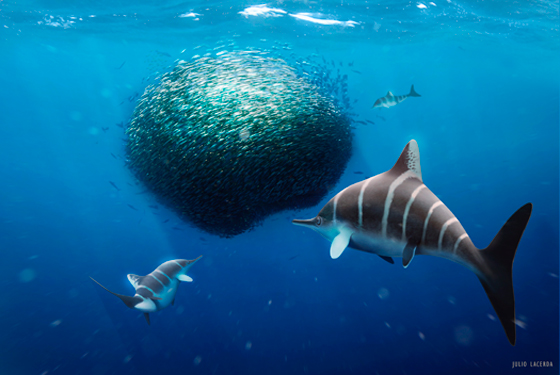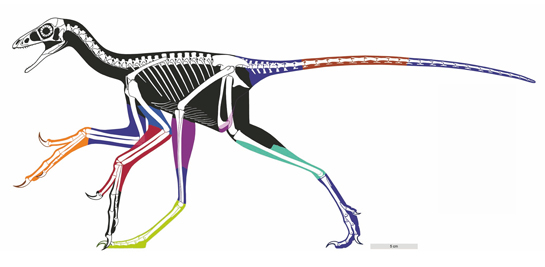Two new species of Hateg Basin sauropods have been identified. Their fossils come from the Upper Cretaceous deposits of the Hateg Basin in western Romania. The discovery of these new taxa can help palaeontologists to better understand dinosaur populations across the planet prior to the end-Cretaceous extinction event. The study led by Verónica Díez Díaz from the Museum für Naturkunde Berlin (Germany) demonstrates how important Europe’s fossils are when it comes to providing a more complete picture of dinosaur extinction.
Scientists from the University College London and the University of Bucharest collaborated in this research.
Hateg Basin Sauropods
The researchers report two new sauropod taxa from the Hateg Basin. They have been named Petrustitan hungaricus and Uriash kadici. During the Late Cretaceous, much of the Europe was covered by water. However, an archipelago existed in what is known today as eastern Europe. The largest island (Hateg Island) was approximately 120 miles (200 km) from the nearest landmass. Size estimates vary, but it has been suggested that by the very end of the Cretaceous (Maastrichtian faunal stage), Hateg Island covered an area of around thirty thousand square miles. It was roughly the size of the Japanese island Hokkaido.
The archipelago was home to several different sauropod taxa. The diversity of sauropods in the Late Cretaceous of Europe is much greater than previously thought. Fifteen years ago, only five sauropod species were known from the Late Cretaceous of Europe. Today, at least eleven taxa have been identified. In contrast, only a single sauropod species is known from the Late Cretaceous of America (Alamosaurus sanjuanensis).
Commenting on the significance of this new study into Hateg Basin sauropods, corresponding author Verónica Díez Díaz (Museum für Naturkunde Berlin) stated:
“The extraordinary diversity in a small geographical area like Hațeg Island surprises us. Sauropods of different sizes lived side by side here: from giants over 10 metres long and weighing eight tonnes to dwarfs of just 2.5 metres and weighing less than a tonne. This provides exciting insights into the environmental conditions and the coexistence of different species.”

The researchers propose the presence of three additional, but only partly contemporaneous taxa in the Hateg Basin. These are Paludititan nalatzensis, Petrustitan (‘Magyarosaurus’) hungaricus and the much larger Uriash kadici. U. kadici is amongst the biggest known sauropods of the Late Cretaceous European Archipelago. Picture credit: Brian Cooley/Dan Horatiu Popa/Hațeg County UNESCO Global Geopark.
Picture credit: Brian Cooley/Dan Horatiu Popa/Hațeg County UNESCO Global Geopark
Giants and Dwarf Sauropods
Traditionally, the fauna of Hateg Island was thought to consist mainly of smaller relatives of dinosaur genera found on larger landmasses. It had been assumed that the dinosaurs of Hateg Island became smaller due to the limited amount of resources on the island. This biological phenomenon is known as island dwarfism (insular dwarfism). This idea was postulated by the famous 20th Century polymath Baron Franz Nopcsa von Felső-Szilvás. He argued that the limited resources such as food, water and space on islands would result in a reduction of the size of animals that lived there. These island dwelling populations would become smaller over many generations when compared to their continental counterparts.
For example, the ornithopod Tethyshadros (T. insularis) was once thought to be a dwarf hadrosauroid. However, subsequent analysis indicates that it was around twenty-five percent larger than previously thought.
To read more about this 2021 study: Sizing up Tethyshadros.
The biota of the Hateg Basin seems to be much more complicated and diverse. For instance, whilst a number of Hateg Basin sauropods are relatively small, the newly described Uriash kadici may have been more than eleven metres in length.
Co-author Zoltán Csiki-Sava (University of Bucharest) added:
“Local evolution was more complex than expected and shows that not all species reduced their size.”
European Dinosaurs Linked to Gondwanan Lineages
This study also highlights the links between European dinosaur taxa and their relatives in Asia, Africa and South America. The team’s findings strengthen the hypothesis that Late Cretaceous European titanosaurs belonged to Gondwanan lineages that invaded the former area during the Barremian–Albian faunal stages of the Early Cretaceous. Paul Upchurch (University College London) explained that Gondwanan sauropods migrated into Europe over land bridges that existed in the Early Cretaceous. However, sauropods were probably very capable swimmers and may have traversed distances in excess of three hundred miles (500 kilometres) to reach distant islands.
Co-author Philip Mannion (University College London) commented:
“Some of these dinosaurs were descendants of earlier faunas, while others arrived in the region late.”
Why were Large Hateg Island Sauropods Present?
The researchers interpret the presence of body-size disparity as either evidence that large-bodied taxa were ecologically excluded from body-size reduction by competition with small-bodied titanosaurs, or that dwarfing occurred stratigraphically earlier among several lineages and the small-bodied titanosaurs on Hațeg Island are the descendants of existing dwarfed ancestors. In addition, the team report that they found no indication of a body size-related titanosaurian turnover in the uppermost Cretaceous of the Transylvanian area.
Everything Dinosaur acknowledges the assistance of a media release from the Museum für Naturkunde Berlin in the compilation of this article.
The scientific paper: “Revision of Romanian sauropod dinosaurs reveals high titanosaur diversity and body-size disparity on the latest Cretaceous Haţeg Island, with implications for titanosaurian biogeography” by Verónica Díez Díaz, Philip D. Mannion, Zoltán Csiki-Sava and Paul Upchurch published in the Journal of Systematic Palaeontology.
The award-winning Everything Dinosaur website: Prehistoric Animal Models and Toys.




Leave A Comment